Korean BBQ beef bulgogi (불고기) is a popular Korean grilled dish made with marinated beef, known for its sweet, savory taste and tender texture (en.wikipedia.org). Traditionally, thinly sliced beef (typically sirloin or ribeye) is marinated in a mixture of soy sauce, garlic, sesame oil, sugar, and various seasonings (en.wikipedia.org), then quickly grilled or stir-fried over high heat. The term bulgogi literally means “fire meat” in Korean (불 bul = fire, 고기 gogi = meat). These 7 beginner-friendly tips will guide you in making juicy, authentic Korean BBQ beef bulgogi at home, even if you’re new to Korean cuisine.
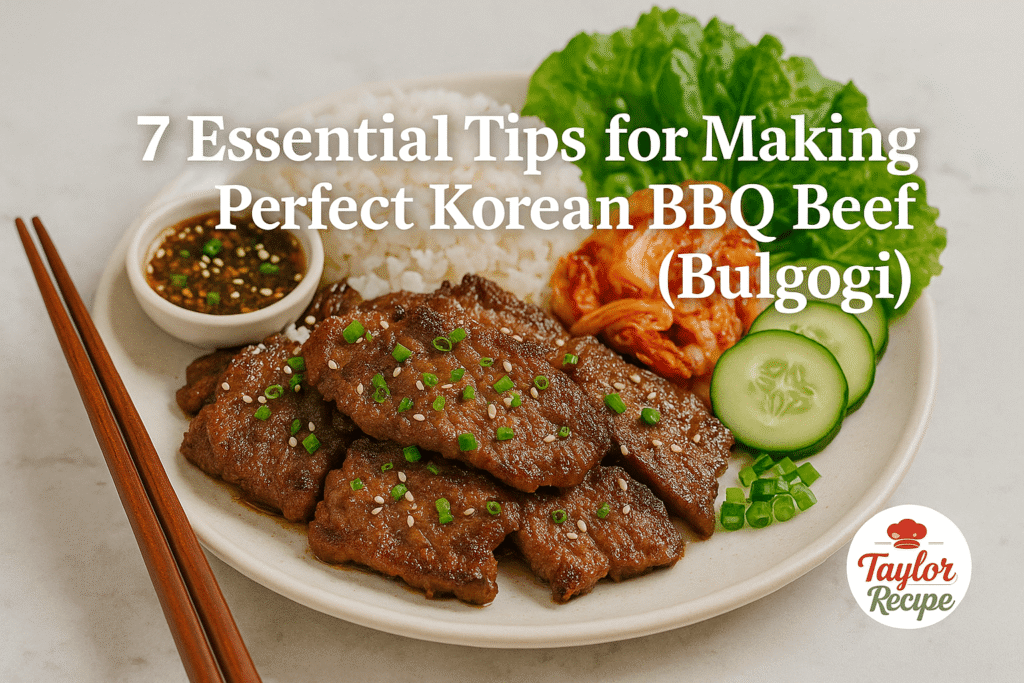
Essential Ingredients for Authentic Bulgogi Marinade
🧂 Traditional Bulgogi Marinade Ingredients:
These ingredients create the signature sweet-savory balance of Korean BBQ beef (bulgogi):
- Soy sauce – 1/4 cup (base of the marinade; adds umami and saltiness)
- Brown sugar or honey – 2 tbsp (sweetens and helps caramelize)
- Sesame oil – 1 tbsp (adds nutty aroma)
- Garlic – 3–4 cloves, minced (classic Korean flavor)
- Onion – 1/2, grated or pureed (adds sweetness and moisture)
- Asian pear or kiwi – 1/2, grated (natural tenderizer and sweetener)
- Ginger – 1 tsp, minced (adds warmth and depth)
- Black pepper – 1/2 tsp (for a subtle bite)
- Mirin or rice wine – 1 tbsp (optional, for acidity and complexity)
- Toasted sesame seeds – 1 tsp (optional, for texture and garnish)
- Green onion – 1, finely chopped (adds freshness)
🥣 Optional for extra flavor:
- Gochujang (Korean chili paste) – 1 tsp (for heat, if you like spicy)
- Fish sauce – 1/2 tsp (adds depth and umami)
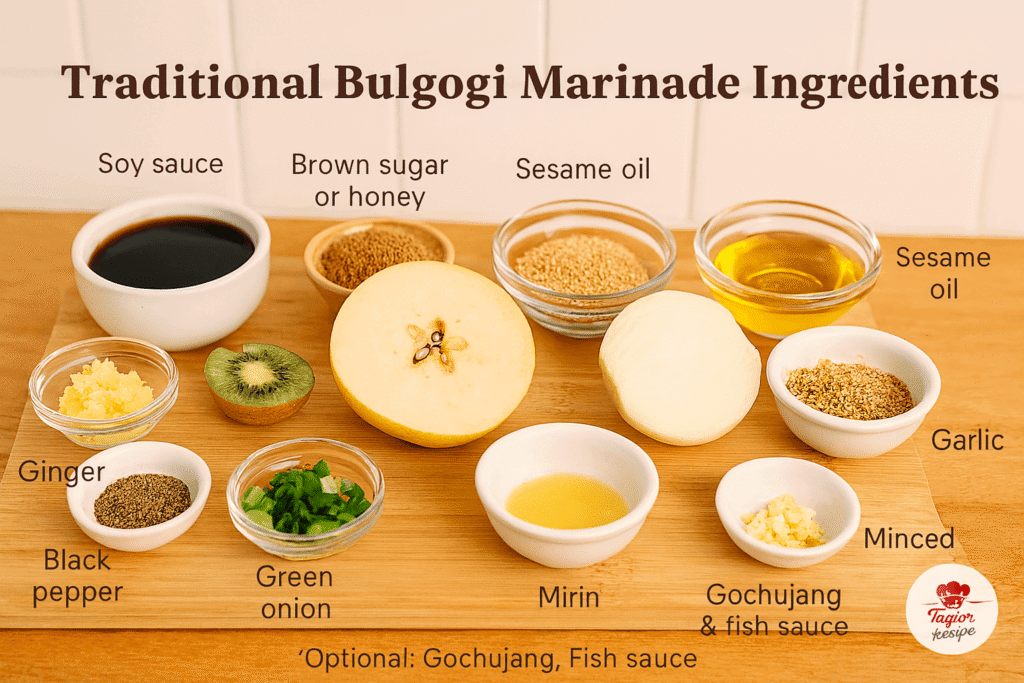
1. Select the Best Beef Cuts for Korean BBQ (Bulgogi)
Start with tender, high-quality beef. Traditional bulgogi uses lean, flavorful cuts like sirloin, rib eye, or chuck eye. These cuts have enough fat marbling for taste but slice well when partially frozen. Avoid very tough cuts (like round or flank) – thin marination can’t fully tenderize them. As Wikipedia notes, bulgogi is usually made from sirloin or rib eye because they’re tender and easy to slice
. Buying meat labeled for “stir-fry” or “carpaccio” can also work. The goal is very thin, small pieces of beef – this maximizes marinade absorption and ensures quick, even cooking.
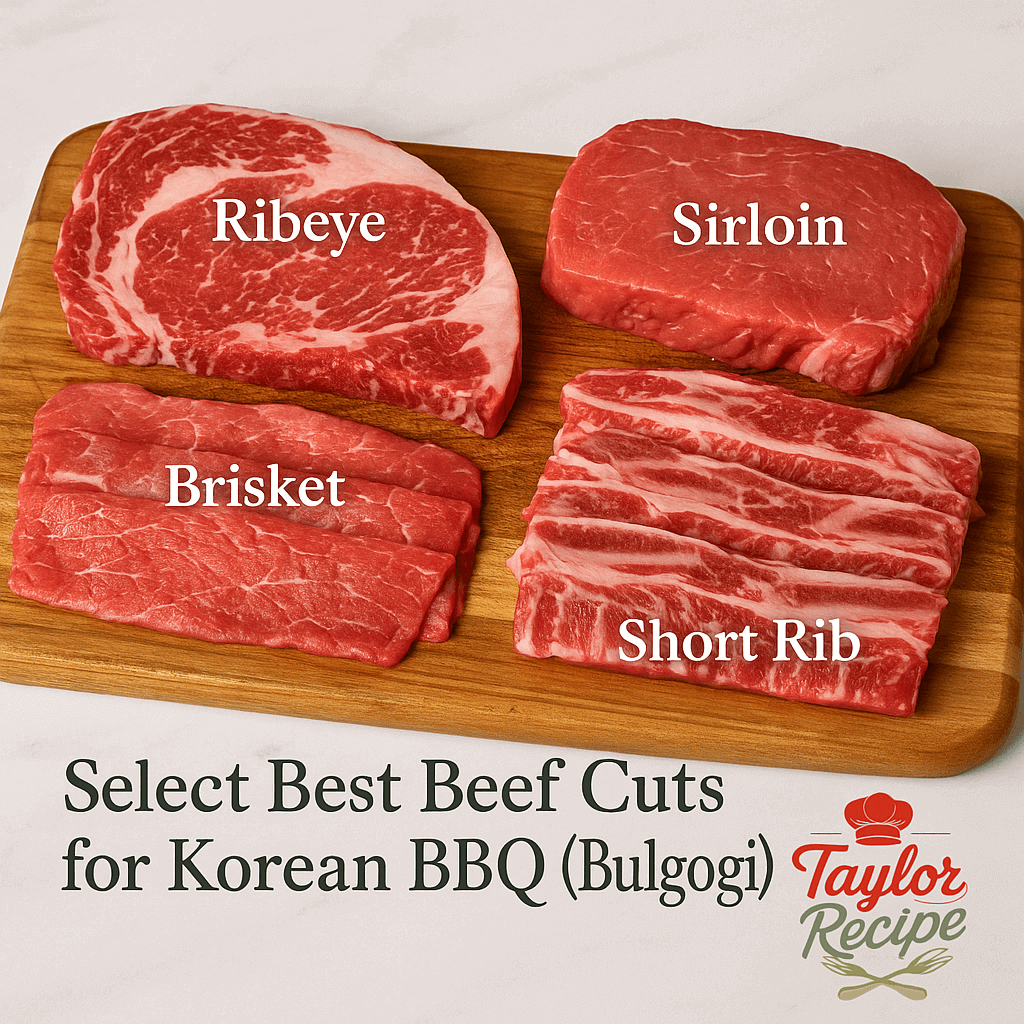
- Tip: If steak is expensive or scarce, beef brisket (thinly sliced) or boneless short ribs (flanken-style) are popular alternatives in Korean BBQ restaurants. Just slice as thin as possible.
- Nutrition note: Beef provides protein and B vitamins. Trimming excess fat helps keep the dish leaner, but a little fat or marbling adds flavor and prevents dryness
- Tip: If steak is expensive or scarce, beef brisket (thinly sliced) or boneless short ribs (flanken-style) are popular alternatives in Korean BBQ restaurants. Just slice as thin as possible.
- Nutrition note: Beef provides protein and B vitamins. Trimming excess fat helps keep the dish leaner, but a little fat or marbling adds flavor and prevents dryness en.wikipedia.org.
2. How to Slice Beef Thinly for Tender Korean BBQ Bulgogi
Bulgogi’s signature tenderness comes from slicing the beef as thin as possible. Aim for 1/8 to 1/4 inch thick (about 3–5 mm) slices. Partially freezing the meat (20–30 minutes) makes slicing into paper-thin strips much easier. Always cut against the grain – this shortens the muscle fibers and makes each bite tender. Thin slices also mean the marinade and heat penetrate quickly, so you don’t overcook the outside while the inside stays raw.
- Technique: Use a sharp chef’s knife and steady strokes. Don’t saw back and forth – a smooth slice will keep the meat’s surface intact for better browning.
- Related tip: Chopping the slices into bite-sized pieces or strips (about 1–2 inches long) helps them cook evenly and makes for perfect lettuce-wrapped mouthfuls.
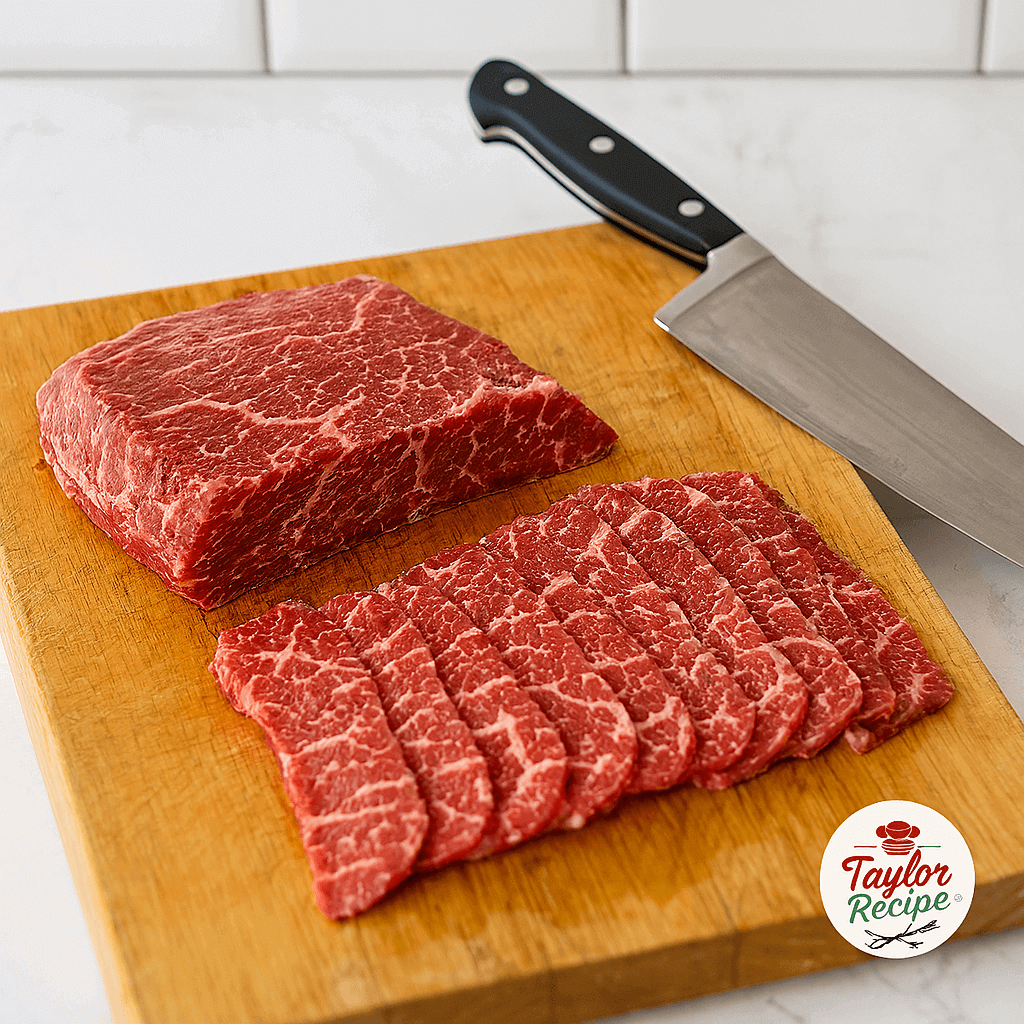
3. Make an Authentic Bulgogi Marinade for Korean BBQ Beef
The marinade is the heart of bulgogi’s flavor. A classic bulgogi marinade combines soy sauce, sugar (or honey), garlic, sesame oil, and sometimes rice wine (mirin) or fish sauce for depth seriouseats.com. Finely grated onion or pear juice adds natural sweetness. To this base, you can add minced ginger, sesame seeds, and a pinch of black pepper for extra aroma seriouseats.com. In short, mix the seasonings into a bowl (for example, “soy sauce, sugar, sesame oil, mirin, onion, garlic, ginger, sesame seeds, and black pepper” as Serious Eats recommends seriouseats.com), then coat the sliced beef thoroughly.
A good bulgogi marinade often includes pureed Asian pear or even kiwi as a natural tenderizer. According to Korean cooking tradition, adding a small amount of pureed pear or kiwi helps break down the meat fibers, resulting in even more tender beef en.wikipedia.org. Sugar or a little honey not only sweetens but also helps the meat brown. If you like a slightly spicy kick, add a dash of gochujang (Korean chili paste) or red pepper flakes, but keep it balanced so you still taste the sweet-salty notes.
This sweet-savory glaze idea is similar to what we use in our honey garlic shrimp recipe taylorrecipe.com – soy sauce, sugar (honey), garlic, and ginger meld into a sticky, delicious sauce. Try that marinade on beef and you’ll see how it glazes the meat beautifully.
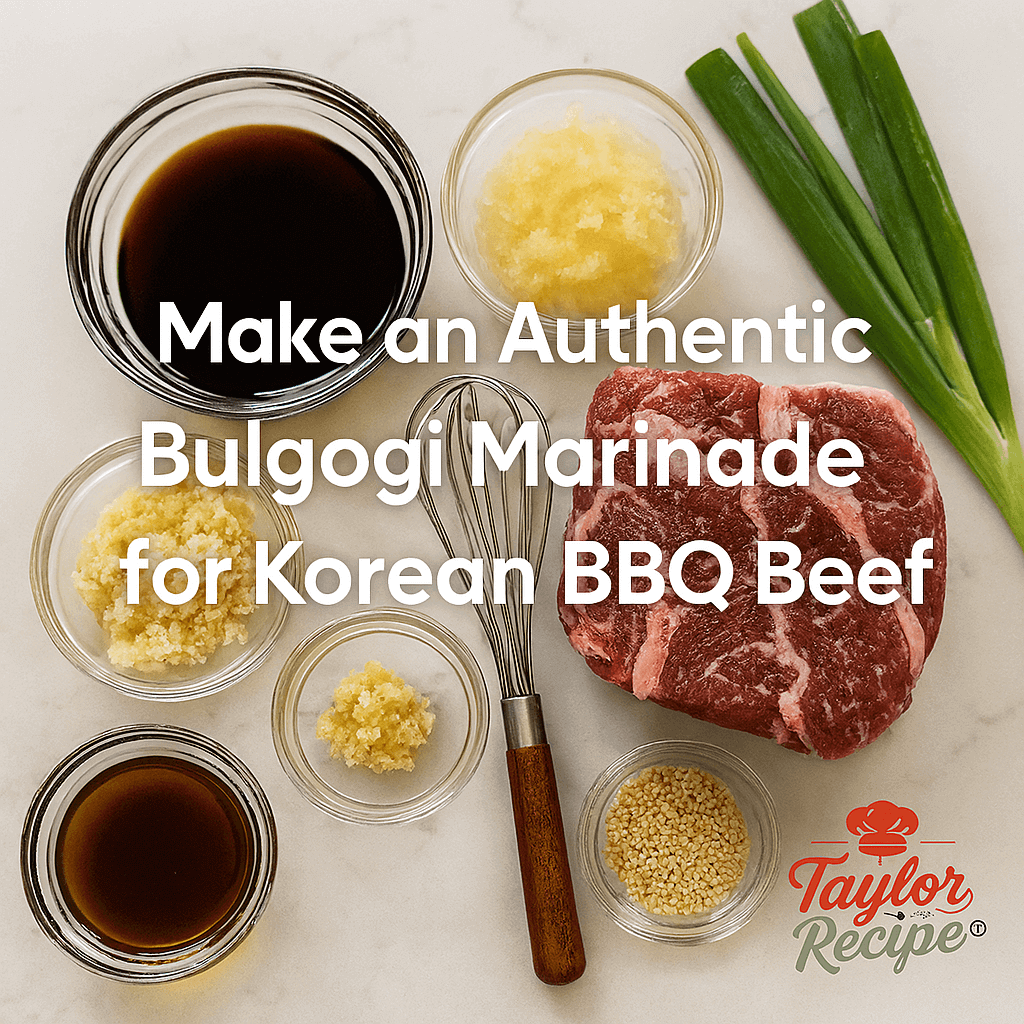
Quick marinade hack: For a quicker version (especially if you forgot to prep in advance), whisk together the ingredients and pour half of it over the beef, while saving the rest to brush on during or after cooking. This way you get maximum flavor even in a short time.
4. Properly Marinate Your Korean BBQ Beef Bulgogi — But Don’t Overdo It
Once your beef is coated in marinade, let it soak in flavor for the right amount of time. For thin bulgogi strips, 30 minutes to 1 hour in the fridge is often enough for great taste en.wikipedia.org. (Some traditional recipes suggest a few hours, but go easy – too long can make the meat mushy.) Stir the marinade and meat occasionally for even coverage. Cover the bowl or use a sealed bag to keep things tidy.
- Tip: If you’re short on time, even 15–20 minutes helps. But if you have an hour or more, the extra sweetness and savory notes really penetrate. Just don’t marinate overnight unless the beef is very thick. According to food tradition, bulgogi usually needs less than an hour of marination for optimal texture en.wikipedia.org.
- Vegetarian note: If you’re curious, you can also marinate thin slices of tofu or eggplant with the same mix (like a vegan bulgogi). The key is the flavor-packed sauce – even non-beef proteins soak it up well seonkyounglongest.com.
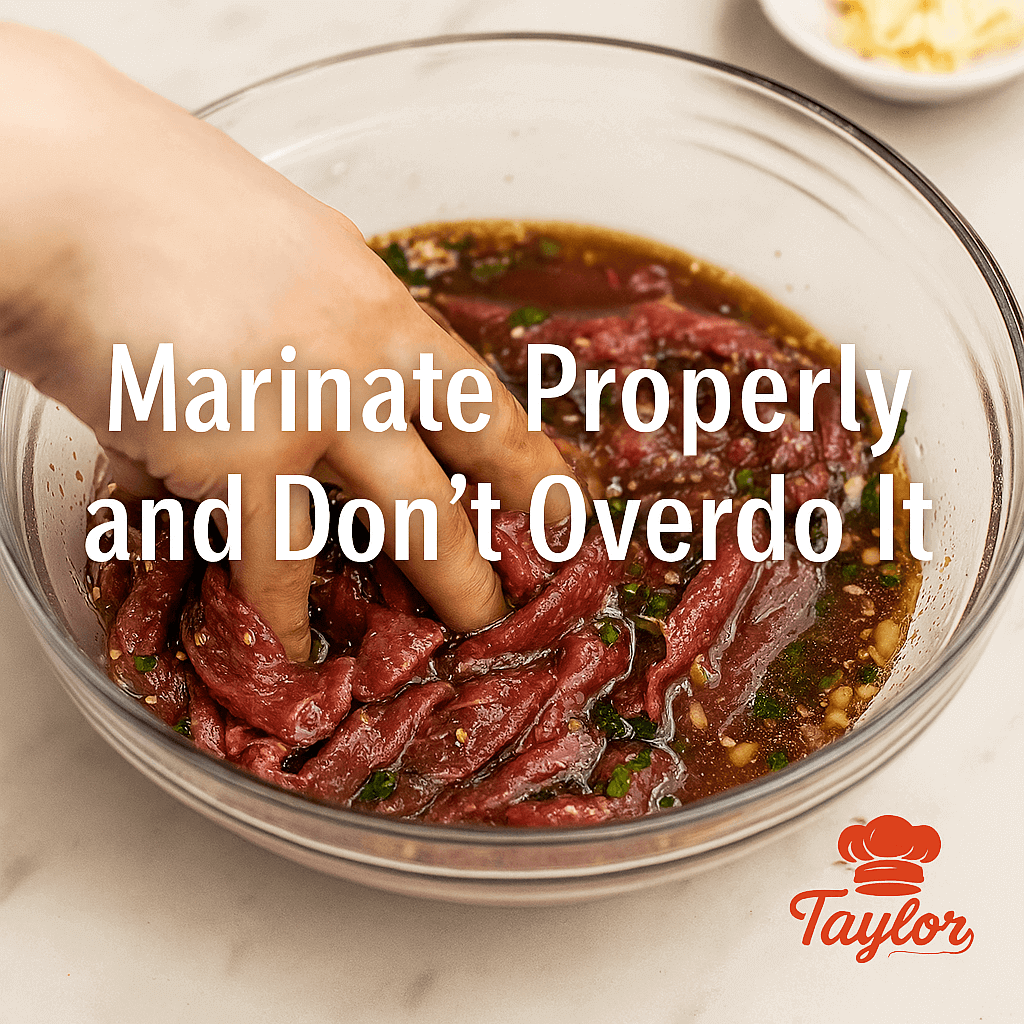
5. Preheat Your Grill or Pan to High Heat
The magic of bulgogi is in the high-heat cook: a screaming-hot grill or skillet will sear the marinated beef quickly, locking in juices and caramelizing the sugars. Like cooking a stir-fry, always start with a piping hot surface
taylorrecipe.com
. This quick sear gives bulgogi its slightly charred, savory-brown edges.
- Grill or pan: For an outdoor Korean BBQ vibe, use a grill or grill pan. If cooking indoors, a cast-iron skillet or a heavy pan works wonderfully. Heat it until just smoking.You might need to cook in batches to avoid overcrowding the pan.
Don’t crowd: Spread the meat in an even layer. If the strips overlap too much, they’ll steam instead of sear. - Pro tip: {Note} As we say for stir-fries, “A hot skillet sears the meat quickly (locking in juices)”taylorrecipe.com. Similarly, don’t pile on too many slices at once. Let each piece make contact with the pan or grill.

6. Cook Quickly and Watch Carefully
Once the pan is heated, add the marinated beef and arrange it in a single layer. It will cook very fast – think 1–2 minutes per side. Flip the slices as soon as they brown. Because the beef is cut so thin, it’s done when it loses its raw color and has nice golden edges. Avoid overcooking, or it’ll dry out. As a rule of thumb, remove the beef just before it’s completely done; it will finish cooking through in the hot residual heat.
- Flavor boosters: In the last few seconds, you can toss in thinly sliced onions, slivers of carrot, or mushrooms to cook alongside the beef – these pick up the bulgogi flavor and make a great mix-in.
- Garlic and green onion: You may also add whole garlic cloves or scallions to the pan briefly for extra aroma (they won’t burn in 30 seconds). Bulgogi is commonly served with grilled green onions or fresh scallions on top.
- Sauce glaze: Any marinade left at the bottom of the bowl can be spooned over the beef as it cooks, but do this sparingly since it contains raw ingredients. Alternatively, drizzle a bit of sesame oil on top right at the end for extra fragrance.
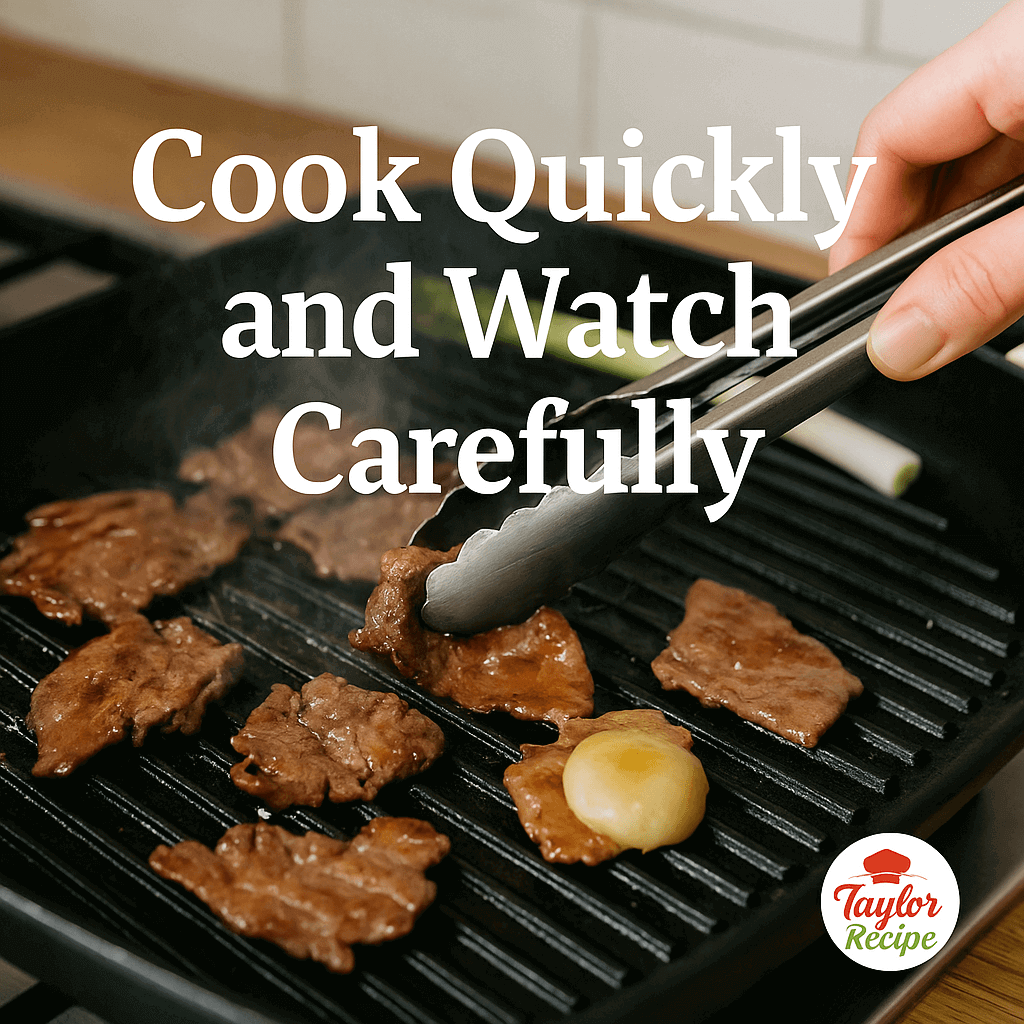
7. Serve with Classic Korean Sides and Garnishes
Bulgogi is traditionally served hot, straight from the grill or pan, with steamed rice and an array of sides. The most common sides are kimchi (spicy fermented cabbage) and fresh leafy greens (like lettuce or perilla leaves) for wrapping. Wikipedia notes that bulgogi is often accompanied by rice and kimchi, and it’s common to serve the beef with lettuce to wrap and ssamjang (spicy bean paste)
en.wikipedia.org.
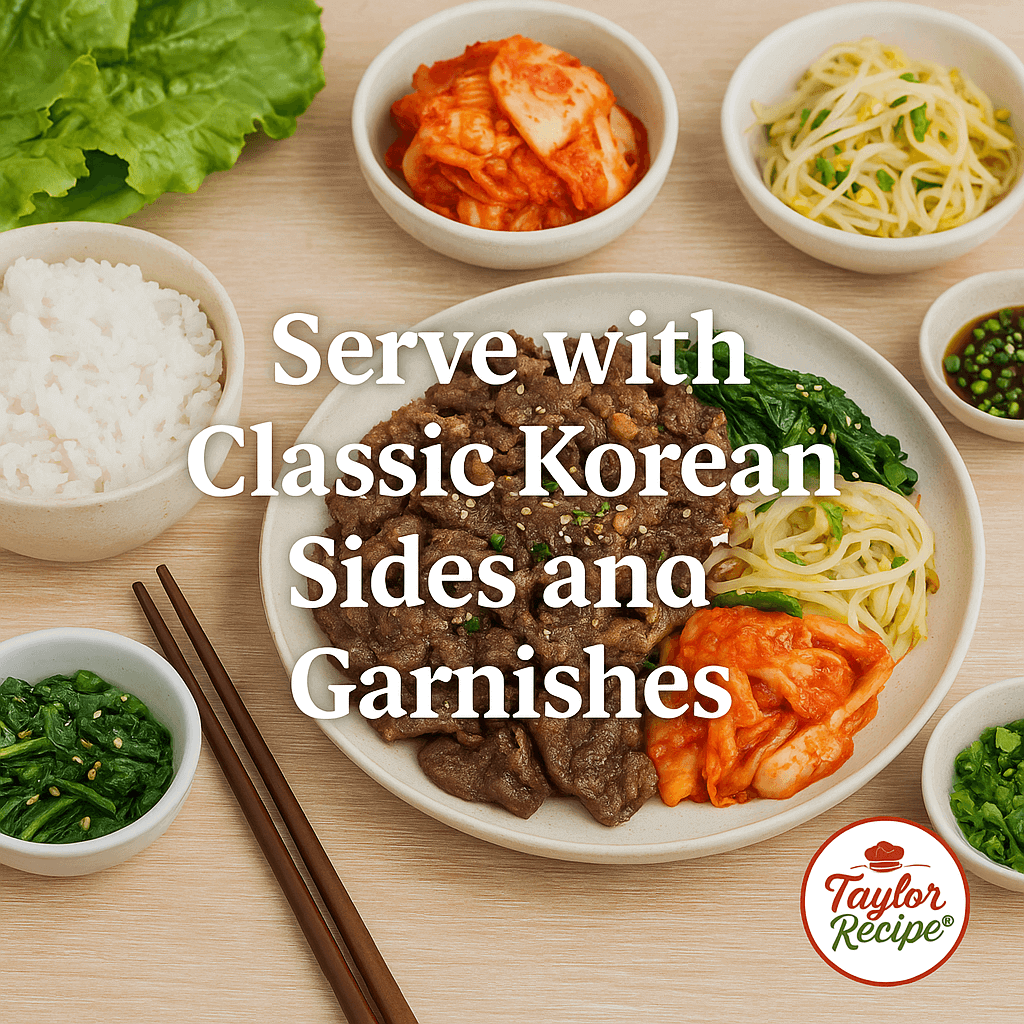
- How to eat: Take a grilled bulgogi slice, a leaf of lettuce, and a dab of gochujang or ssamjang. Wrap it all together and eat in one bite – the spicy-sweet combo is irresistible.
- Garnishes: Finish with a sprinkle of toasted sesame seeds and finely chopped green onions to enhance both color and flavor. A light squeeze of fresh lime or a drizzle of soy-citrus sauce (cho-gochujang) can brighten the dish.
- Other sides: Serve it with simple banchan (Korean side dishes) like pickled radishes, sliced cucumbers, or a quick cucumber salad. These refreshing sides complement the richness of the beef perfectly.
- Enjoy: Bulgogi can also be served over a bed of white or brown rice, or even in a bowl with rice and a fried egg on top. In Korean BBQ restaurants, people often grill the meat right at the table and eat it all together, making any meal feel festive.
Conclusion
Mastering Korean BBQ beef (bulgogi) takes a bit of practice, but these tips cover the essentials: use tender cuts, slice thin, make a sweet-savory marinade, and cook the meat quickly at high heat en.wikipedia.org seriouseats.com. Don’t forget to let the marinade work (it tenderizes the meat if you include fruits like pear en.wikipedia.org) and to garnish your cooked bulgogi with sesame and green onion for extra aroma. Serve it up in lettuce wraps or with rice and kimchi for a truly authentic experience en.wikipedia.org.
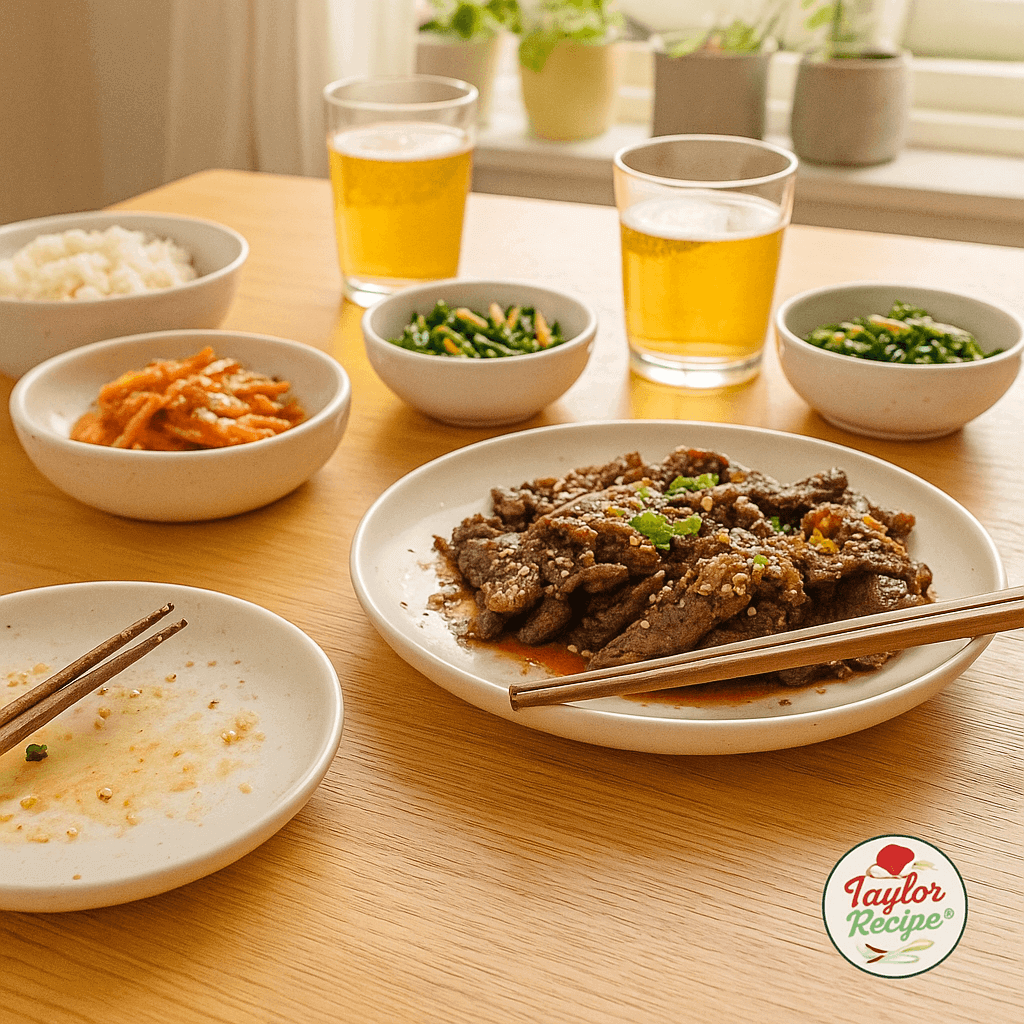
We hope these beginner-friendly tips help you grill up perfect bulgogi at home. If you tried this guide or have your own bulgogi secrets, please leave a comment below and share your tips or questions. Enjoy your delicious Korean BBQ feast, and don’t forget to share this post with friends who love cooking!
Happy grilling and annyeong (안녕)!
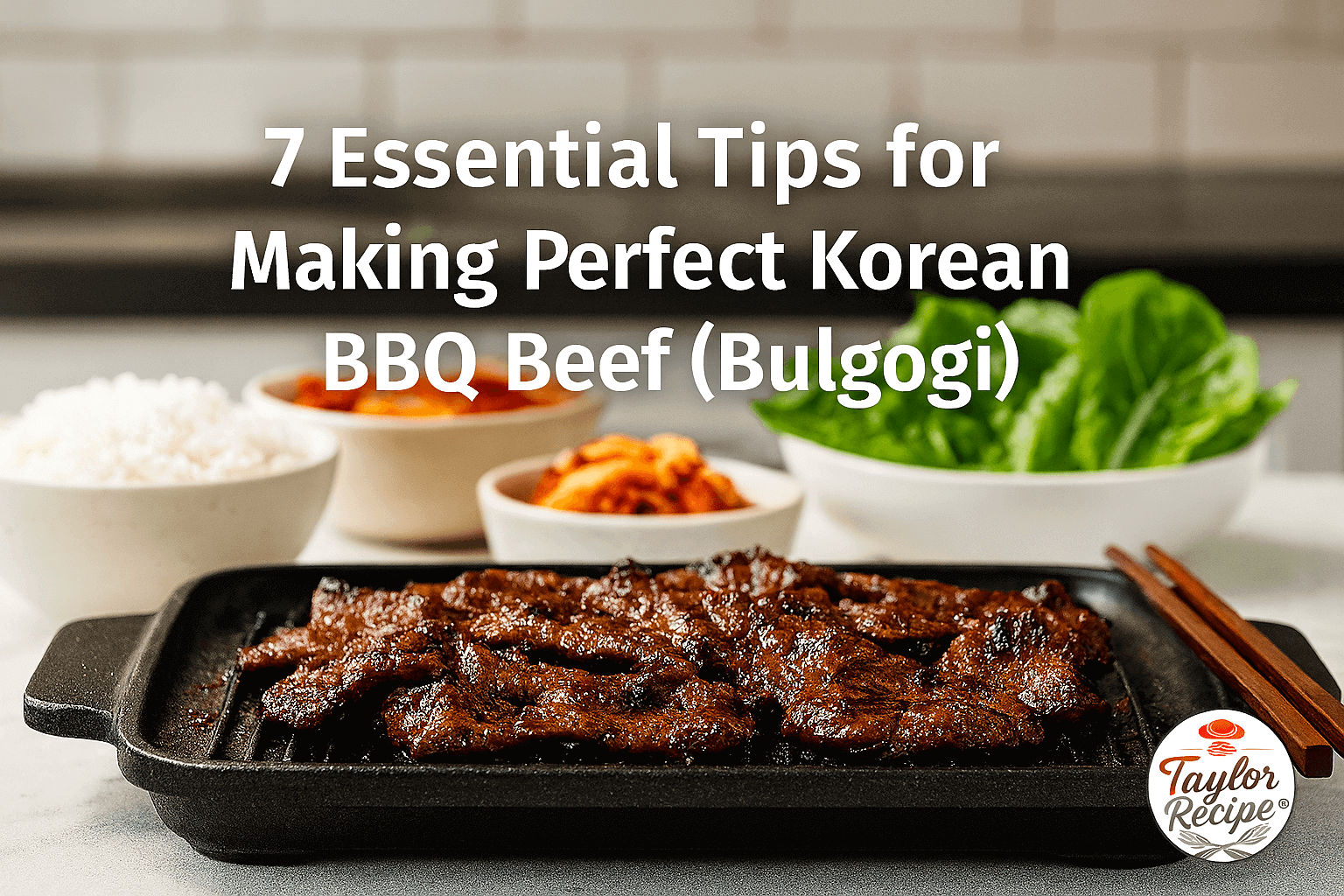
1 thought on “7 Essential Tips for Making Perfect Korean BBQ Beef (Bulgogi)”
Comments are closed.